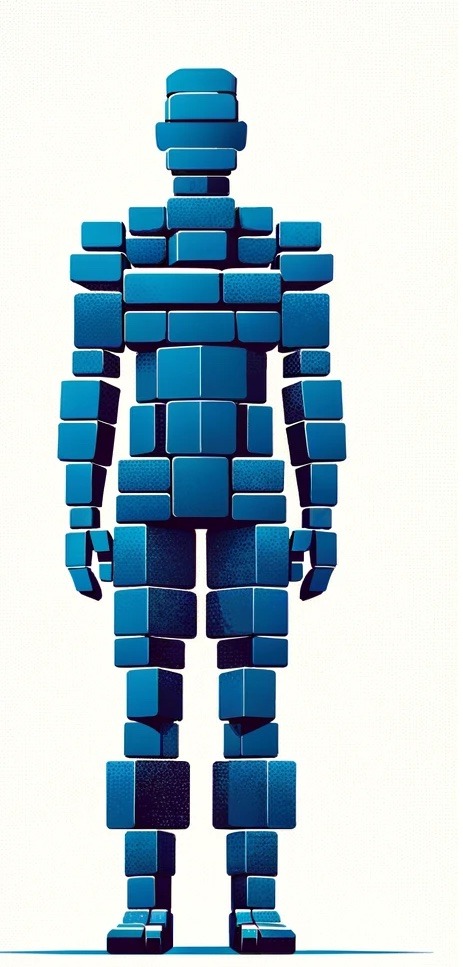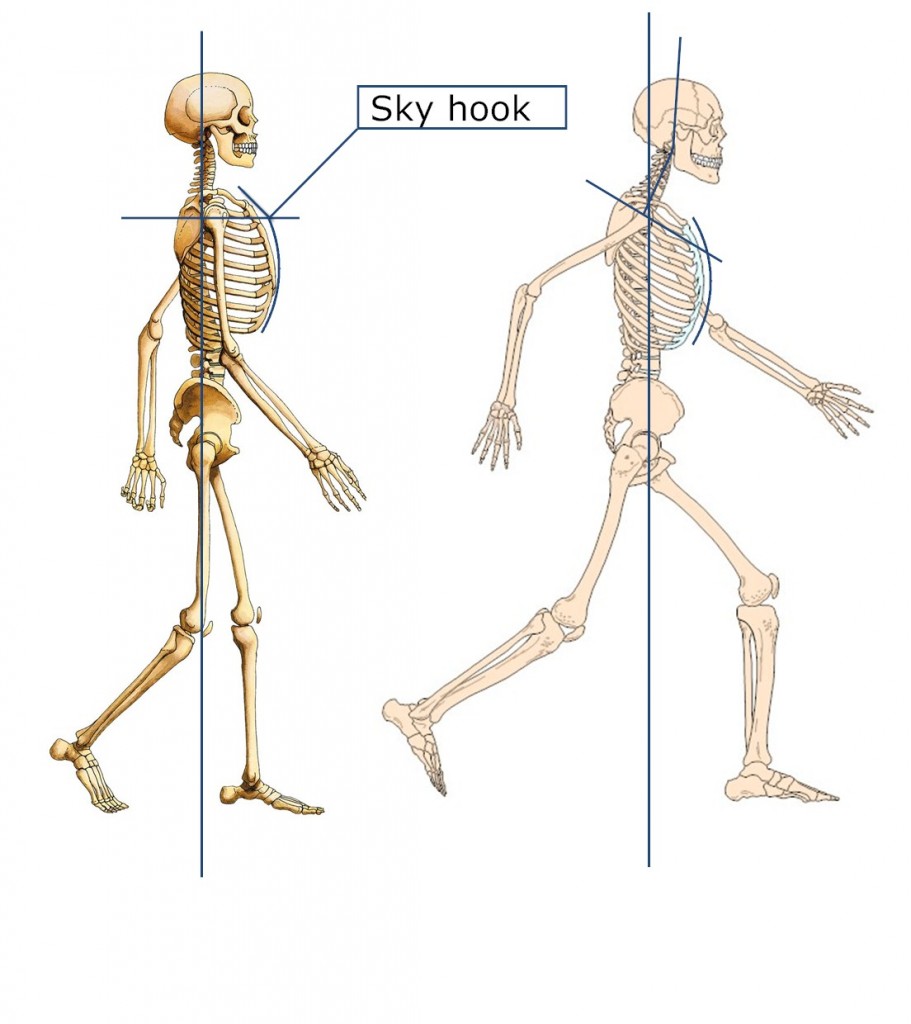Correct alignment of posture is commonly presented as a gravity line intersecting the ear, shoulder, hip, knee, and ankle. While in a static standing pose this alignment allows the compressive skeletal attributes to “stack” with body weight translating through them to the ground. It is a passive stance with the tensional attributes(muscles) performing a minor role in balancing the compressive elements. This traditional mechanistic “stacked block” perspective presumes the articulations perform similarly to joints and levers in a solid assembly, as in the design of robots. This conceptual framework is not otherwise observed in nature and although we have evolved this capability, it is a derivative, rather than a primary function of our musculoskeletal system. It is reasonable to consider the heels of our feet as another mechanism of sitting, like our Sit Bones – by stacking our body weight above our heels we deactivate much of our musculoskeletal functionality as when sitting. This is a useful quality, but using it as the primary mechanism of stance compromises our regenerative capacities.
Animals are living things that move, and the role of our musculoskeletal system is action. Action necessitates the dynamic interplay of our tensional and compressional (muscle and bone) elements. There is extensive discussion in this blog on tension and compression mechanics, called Tensegrity1. How we move influences the qualities of our connective tissue matrix, which in turn influences how we move. Without outside influence, this circular causality will tend to entropy/degeneration/depreciation.
The question is: What outside influences minimize this entropic tendency and maximize the regenerative potentials within our connective tissues? Presented here is a definition of the gravitational center of mass of the body – so-called “good posture”, founded on Tensegrity principles and measurable force dynamics. Organizing movement to originate from this alignment facilitates optimal recreation of our connective tissue matrix2. It is a fluid and instinctual reference spontaneously embodied once accessed.
THE KINSEGRITY LINE
The dynamic/active interplay of tension and compression within animal locomotion is presented using the portmanteau of kinematics and tensegrity: KINSEGRITY3. A gravity line – a line through our vertical center of mass accurately representing our dynamic motor functions, would be anterior to a static, compressional gravity line, allowing for a balanced interplay of these elements even while standing.
Kinesgrity Landmarks:
The landmarks for the gravity line encompassing Kinsegrity mechanics are somewhat obscure:
- Stella Turcica (behind the eyes in the Sphenoid bone)4
- Manubrium(top of chest)5
- Pubis Symphisys(front of the pelvis)
- Patella(front of the knee)
- Ball of the Foot.
They are represented in the gravity line graphics (except for the knee, which should not be hyperextended (locked). Following this line it can be easily visualized that the energy of a vertical shock load, for example, while running, can be elastically absorbed by this structural alignment, redistributed across the body, and input into the next action. In the traditional gravity line, this energy propagates as high-frequency pressure waves (shock), promoting wear and tear of the compressive interfaces.6
When the body is viewed as a compressive, “stacked” structure the concept of a line describing the gravitational center of mass has utility. However, when the body is viewed as a set of dynamic compressional/tensional nodes translating stress/strain holistically throughout the body, the concept of a single defining line is insufficient and is presented here in contrast to the traditional viewpoint.
If the practice of aligning one’s structure while standing and moving using the Kinsegrity landmarks is undertaken, it will be discovered that there is an extended scope of action engaging more of our innate musculoskeletal functions (reflexes) and structures.
When utilizing this dynamic in gait, the feet execute posterior of this line. The rate at which one moves defines stride rate instead of how we usually consider this – stride rate determining the rate of movement, resulting in the feet seldom contacting the ground ahead of the Kinsegrity Line7.
GRAVITY LINES: TRADITIONAL AND KINSEGRITY
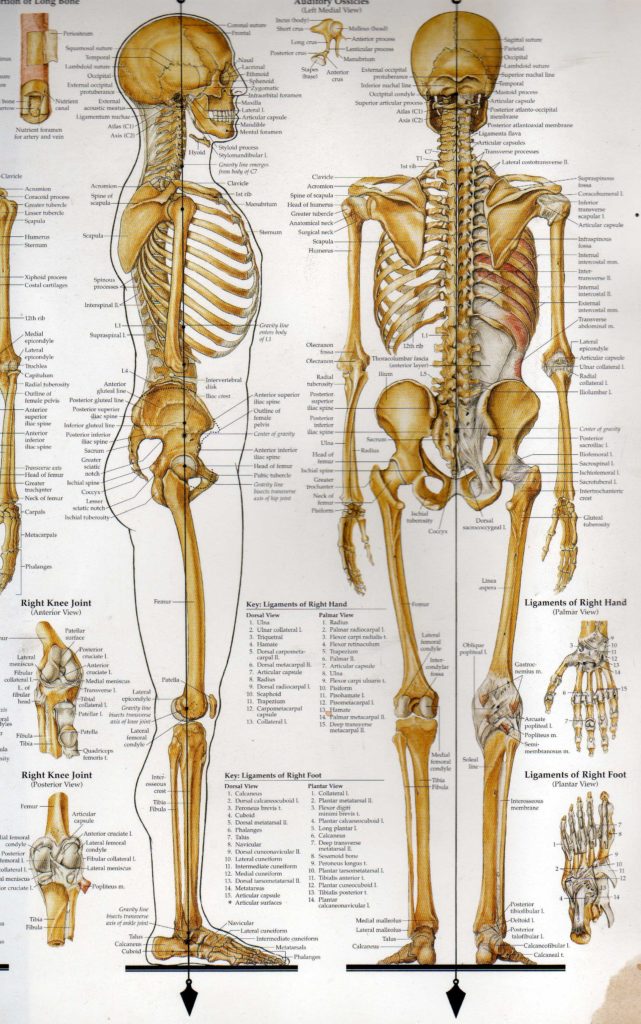
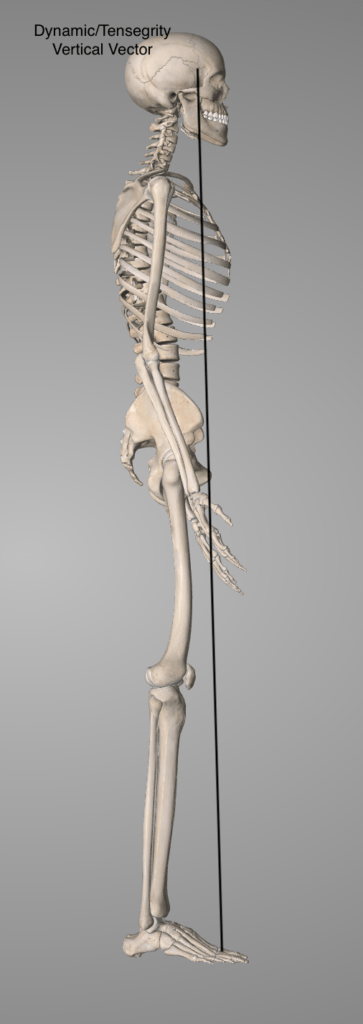
FOOT – FUNCTION FROM STRUCTURE RELATING TO THE LINES
Videos showing the structural alignment of the foot in the traditional and the Kinsegrity gravity line postures, using only the functional bones. Click on the square icon for a full-screen view.8
Traditional
Kinsegrity
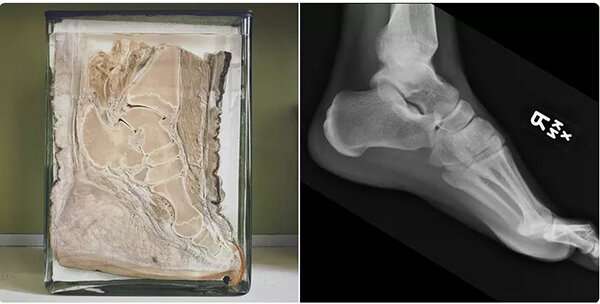
Showing Integrated Tensegrity Dynamics Present within a Massive Organism.
Note the similarity to a dynamic gait form – it has the same architecture as a human foot and the functional position for shock absorptive gait.
PUTTING ON PANTS WHILE STANDING
If you try putting your pants on while standing with your weight mostly at the heel of the foot, it is more challenging to maintain your balance. However, shifting your weight forward dominantly on the ball makes putting on pants significantly easier while standing. This is a simple demonstration of the premise presented in this post for dynamic organization within the gravitational effect.
FOOTNOTES
- There is extensive commentary on the interplay of tensional and compressional dynamics within animals in this category of posts:
TENSEGRITY AND CONNECTIVE TISSUE ↩︎ - Our Connective Tissue matrix includes not only the inert collagen fabrics and their supporting cellular factories, but also muscles and their control (nervous system) mechanisms. Organizing the connective tissue matrix embodies retraining the associated reflexes. ↩︎
- This post discusses the concept of
KINSEGRITY ↩︎ - This post discusses the cranial aspects of this gravity line:
SPHENOID-OCCIPUT/ATLAS AXIS COMPLEX ↩︎ - This post discusses the sternal aspects of this gravity line:
THE STRUCTURAL INTERFACE BETWEEN THE HOMUNCULUS AND THE LOCOMOTIVE CORE ↩︎ - This post discusses how high-frequency shock loads are not well received by the cells responsible for connective tissue maintenance:
MECHANOTRANSDUCTION OF FIBROBLASTS AND OSTEOCLASTS ↩︎ - This style of walking is sometimes described as Forefoot Gait. Movement manifests at the threshold between stability and instability as discussed in this post:
GREATER STABILITY THROUGH INSTABILITY. ↩︎ - A more detailed discussion of foot function can be found in this post:
FEET – FUNCTION FROM STRUCTURE ↩︎

